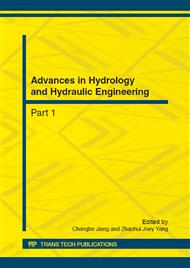p.345
p.351
p.358
p.362
p.366
p.372
p.377
p.383
p.391
Experimental Study of Sand Sediments Effects on Submerged Hydraulic Jump Properties
Abstract:
Abstract. In this study, the effect of sediment concentration on submerged hydraulic jump (SHJ) characteristics such as jump length, submerged depth on the gate and the energy dissipation is investigated. Experiments were carried out in a flume of 46 cm depth, 12 m length. The width of the flume changes from 10 cm (at the entrance) to 60 cm (at the exit). Sediment load and flow concentration have an influence on submerged hydraulic jump characteristics including submerged depth on the gate, jump length and relative energy dissipation. It is shown that at high Froude numbers increasing the suspended sediment concentration to 28.7 gr/l leads to a reduction in the submerged depth on the gate up to 6% and jump length up to 10%. Also, the energy dissipation of the submerged hydraulic jump increases by 4% and turbulence resulting from the jump leads to upright distribution of concentration at the end of the jump. Also in concentrations higher than 30 gr/l, flow is not able to carry the whole sediments and subsequently leads to their deposition in subcritical area and behind the sluice gate.
Info:
Periodical:
Pages:
366-371
Citation:
Online since:
October 2012
Price:
Сopyright:
© 2012 Trans Tech Publications Ltd. All Rights Reserved
Share:
Citation:


